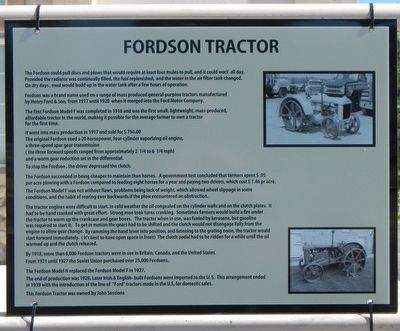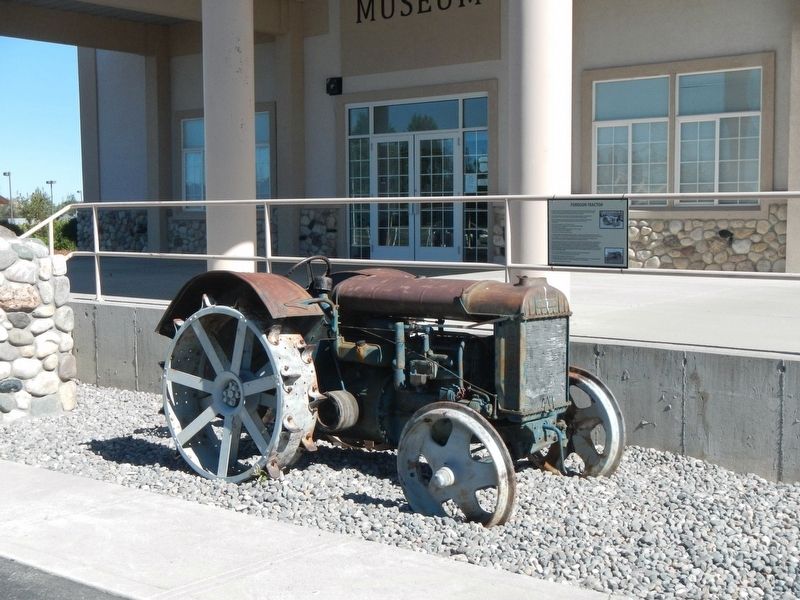Driggs in Teton County, Idaho — The American West (Mountains)
Fordson Tractor
Fordson was a brand name used on a range of mass produced general-purpose tractors manufactured by Henry Ford & Son, from 1917 until 1920 when it merged into the Ford Motor Company.
The first Fordson Model F was completed in 1916 and was the first small, lightweight, mass-produced affordable tractor in the world, making it possible for the average farmer to own a tractor for the first time.
It went into mass production in 1917 and sold for $750.00. The original Fordson used a 20 horsepower, four-cylinder vaporizing oil engine, a three-speed spur gear transmission (the three forward speeds ranged from approximately 2 1/4 to 6 1/4 mph) and a worm gear reduction set in the differential. To stop the Fordson, the driver depressed the clutch.
The Fordson succeeded in being cheaper to maintain than horses. A government test concluded that farmers spent $.95 per acre plowing with a Fordson compared to feeding eight horses for a year and paying two drivers, which cost $1.46 pr (sic) acre. The Fordson Model F was not without flaws, problems being lack of weight, which allowed wheel slippage in some conditions, and the habit of rearing over backwards if the plow encountered an obstruction.
The tractor engines were difficult to start. In cold weather the oil congealed on the cylinder walls and on the clutch plates. It had to be hand cranked with great effort. Strong men took turns cranking. Sometimes farmers would build a fire under the actor to warm up the crankcase and gear boxes. The tractor when in use, was fueled by kerosene, but gasoline was required to start it. To get in motion the gears has to be shifted and the clutch would not disengage fully from the engine to allow gear change. By ramming the hand lever into position, and listening to the grating noise, the tractor would start forward immediately. (It's best to have open space in front) The clutch pedal has to be ridden for a while until the oil warmed up and the clutch released.
By 1918, more than 6,000 Fordson tractors were in use in Britain, Canada and the United States. From 1921 until 1927 the Soviet Union purchased over 25,000 Fordsons.
The Fordson Model N replaced the Fordson Model F in 1927. The end of production was 1928. Later Irish- and English-built Fordsons were imported to the U.S. This arrangement ended in 1939 with the introduction of the line of "Ford" tractors made in the U.S. for domestic sales.
This Fordson Tractor is owned by John Sessions.
Erected by Teton Valley Historical Museum.
Topics. This historical marker is listed in this topic list: Architecture. A significant historical year for this entry is 1917.
Location. 43° 44.601′ N, 111° 6.629′ W. Marker is in Driggs, Idaho, in Teton County. Marker is on State Highway 33 near Valley Centre Drive, on the left when traveling south. Touch for map. Marker is at or near this postal address: 1409 Idaho Highway 33, Driggs ID 83422, United States of America. Touch for directions.
Other nearby markers. At least 7 other markers are within 4 miles of this marker, measured as the crow flies. Tetonia School Bell (within shouting distance of this marker); John Colter (approx. 1.3 miles away); Teton County Veterans Memorial (approx. 1.3 miles away); Pierre's Hole Rendezvous and Battle (approx. 2˝ miles away); Teton Range (approx. 3.4 miles away); a different marker also named John Colter (approx. 3.4 miles away); Pierre's Hole (approx. 4.1 miles away).
More about this marker. The Fordson Tractor is in front of the Teton Valley Historical Museum.
Also see . . . Fords - Wikipedia. Between 1917 and 1922, the Fordson was for tractors somewhat like the Ford Model T was for automobiles—it captured the public's imagination and widely popularized the machine, with a reliable design, a low price affordable for workers and farmers, a widespread dealership network, and a production capacity for large numbers. Just as the Model T helped the public to appreciate how soon cars and trucks might replace most horses in transport, the Fordson helped people to appreciate how soon tractors might replace most horses in farming (advancing the mechanisation of agriculture). (Submitted on September 18, 2017, by Barry Swackhamer of Brentwood, California.)
Credits. This page was last revised on September 18, 2017. It was originally submitted on September 18, 2017, by Barry Swackhamer of Brentwood, California. This page has been viewed 739 times since then and 64 times this year. Photos: 1, 2. submitted on September 18, 2017, by Barry Swackhamer of Brentwood, California.

